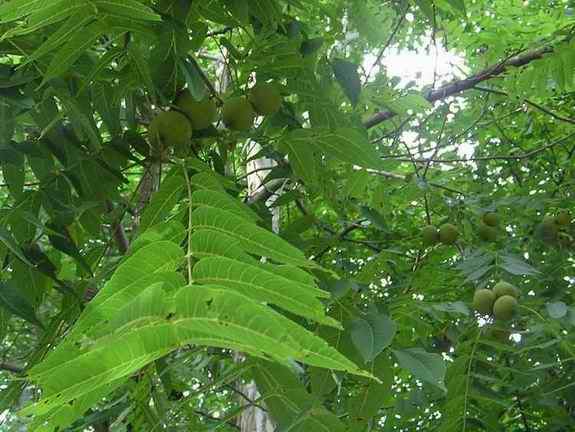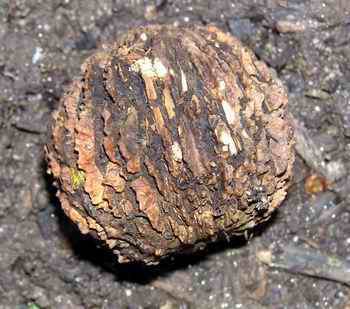|
Return to Hiker's Notebook Home Page
Common Name: Black Walnut, American Walnut, Virginia Walnut, Eastern Black Walnut (Walnut is derived from the Welsh wealh meaning foreign and hnutu meaning nut; the tree was introduced from Gaul and Italy to England, where it was called foreign nut to distinguish it from the native hazel nut). Scientific Name Juglans nigra (The generic name is from the Latin iovis meaning Jove or Jupiter - there was no "J" until the 15th Century - and glans meaning nut, literally Jupiter's Nut; nigra is Latin for black).
The Black Walnut is the tallest of twenty species of the Juglans genus worldwide of which six are native to North America. They are characterized by distinctive compound leaves that have an odd number of pointed, lanceolate leaflets ranging from 7 to 23. They are monoecious; both male and female flowers residing on the same tree. They are noted for their fruit, an oil-rich nut in a ridged, hard black shell surrounded by a thick green non-splitting husk and for their hard, durable and esthetic heartwood.
The Black Walnut produces a chemical substance called juglone (from the genus name Juglans) that is toxic to many other plants. The toxin, 5-hydroxy-alphanapthaquinone, is produced mainly by the roots which extend radially outward from the trunk to a distance of up to 80 feet. Many plants are affected by the chemical, notably tomato, potato, blackberry, blueberry, mountain laurel, rhododendron and apple; injury or death resulting from an exposure of several months. Animals, notably horses, are also affected by juglone. Small amounts of walnut chips or sawdust in equine bedding can result in a laminitis, an inflammation of the layers, or laminae, of the hooves. In severe cases, swelling in all four legs, edema of the abdomen and colic can result in death.
The poisoning of one plant by another is known as allelopathy, from the Greek allel meaning "of one another" and pathos meaning disease. It was first described by Pliny the Elder, a Roman naturalist in 77 CE, noting the toxic effects of the walnut tree on its surrounding plants. Allelopathy is a survival adaptation of a number of plants, including sugar maple, sycamore, cottonwood, and black cherry. The effects of black walnut are generally more pronounced, resulting in wilting, foliar yellowing, and eventual death. Experimentation has demonstrated that juglone is a respiration inhibitor that deprives sensitive plants of metabolic activity.
Black Walnut bark and nut husks have been used for medicinal purposes for millennia, taking advantage of the allelopathic properties of juglone. It is purported to be a superior antiseptic, high in iodine, and an excellent treatment for any kind of fungus condition. A bark poultice was used by the Greeks and the Romans to treat a skin fungus known as dermatomycosis. Native Americans used the inner bark to make a laxative tea and chewed the bark as a palliative for toothaches; it is still used as a dentifrice in Pakistan. A tincture of black walnut made with grain alcohol and the green husks of the fruit is said to kill the larvae and adult stages of some 100 parasites. A known vermifuge, it expels pinworm, ringworm and other parasites from the intestinal tract. Juglone has also been found to have a sedative capacity similar to that of diapezam, the ingredient in Valium.
The commercial Persian walnut (J. regia) is native to Asia Minor. First
cultivated in Persia, it was spread throughout Europe by the Romans. It is
more commonly called English walnut as English colonists brought it to North
America, making its way to California with ear
The fruit of the walnut is a nutritious and healthful natural food. It has one of the highest ratios of polyunsaturated to saturated fat ratios (7 to 1) an attribute that contributes to a lowering of harmful LDL cholesterol levels. Walnuts also contain alpha-linolenic acid, or ALA, an omega-3 fatty acid similar to those found in fish that have been found to ameliorate abnormal heart rhythms. A recent study concluded that consumption of a diet in which walnuts replaced a significant portion of saturated fat intake resulted in an 11 percent reduction in cholesterol over a twelve-week period. In March of 2004 the U. S. Food and Drug Administration ruled that foods containing walnuts could be labeled as heart-healthy based on the fact that "supportive but not conclusive research shows that eating 1.5 ounces of walnuts per day ...not resulting in increased caloric intake... may reduce the risk of coronary heart disease."
The medicinal properties of the walnut were recognized in a metaphysical sense through the philosophical notion proposed by Jacob Boehme in the 16th Century known as the doctrine of signatures. This philosophy, which had a religious origin but practical application, maintained that God sought to become manifest through the placement of living things on the earth's surface with an appearance that suggested, or gave a signature to, their use. Thus a plant that looked like a tooth (Cut-Leaved Toothwort) must be good for toothache and a plant that looked like a liver (Hepatica) must be good for biliousness. This applied to walnuts, as noted by William Cole, an exponent of the doctrine of signatures, who wrote in his book on the subject Adam in Eden in 1657 that "Wall-nuts have the perfect Signature of the Head." In his rather detailed anthropocentric assessment of the walnut's qualities, the outer husk of the nut bore the signature of the scalp, as it was covered with light fuzz. A tonic made from the husk must then be a remedy for head wounds. The nut "hath the signature of the skull" and the "kernel hath the very figure of the brain." Therefore, the nut is "very profitable for the brain and resists poysons." The treatment recommended was for the nut to be moistened with wine and put on the head, where it "comforts the brain and head mightily."
|

 ly
missionaries. About 340,000 tons of English walnuts are harvested each year
almost exclusively in California compared to 20,000 tons of black walnuts
primarily in the southeast. This is due primarily to the nature of the
shell, the black walnut having a thick and intractable shell from which the
kernel is difficult to extract whole. Consequently, most black walnut nuts are
used in home baking and in commercial ice cream and candy manufacture. The
heavy shells are ground up to make blasting grit, anti-skid additives to tire
rubber, and activated carbon. The nut husks are processed to produce a yellow
dye and oil that is used in soaps, paints and in cooking.
ly
missionaries. About 340,000 tons of English walnuts are harvested each year
almost exclusively in California compared to 20,000 tons of black walnuts
primarily in the southeast. This is due primarily to the nature of the
shell, the black walnut having a thick and intractable shell from which the
kernel is difficult to extract whole. Consequently, most black walnut nuts are
used in home baking and in commercial ice cream and candy manufacture. The
heavy shells are ground up to make blasting grit, anti-skid additives to tire
rubber, and activated carbon. The nut husks are processed to produce a yellow
dye and oil that is used in soaps, paints and in cooking.